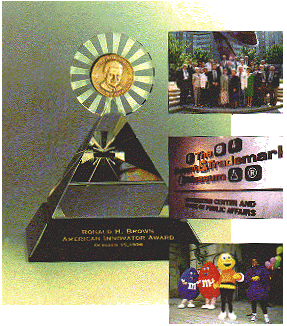
The Patent and Trademark Office has identified two goals for the agency. The first is to:
1. Be a leader in intellectual property rights policy development.
Participate in International Cooperative Arrangements
The PTO participates actively in international negotiations, consultations, and information-sharing efforts to develop and improve systems for the effective grant and protection of intellectual property rights. FY 1996 was an especially active year for these efforts.
Intellectual Property Conference of the Americas
The PTO and co-sponsors from the private sector organized the Intellectual Property Conference of the Americas, which took place in July 1996 in Santa Monica, California. The U.S. Agency for International Development provided support and helped bring together almost 500 participants from the public and private sectors throughout the Western Hemisphere.
Conference participants looked at ways they might cooperate in the search and examination of patent and trademark applications and explored the potential for hemisphere-wide patent and trademark applications. They also examined ways in which countries could exchange information, training, and technical assistance in order to meet their obligations under bilateral, regional, and international agreements and generally to improve enforcement of intellectual property rights throughout the Western Hemisphere.
Participants significantly increased their understanding of the relationship between the positions and needs of the countries of the Western Hemisphere and the establishment and maintenance of effective intellectual property protection systems. Participants formed working relationships that will lead to information sharing and cooperation in planning, training, and technical assistance. Intellectual property owners throughout the Western Hemisphere will be the beneficiaries.
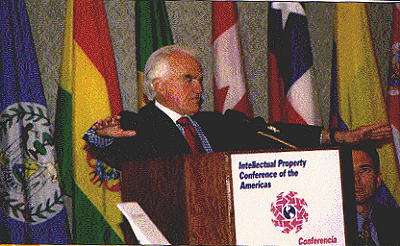
Berne Protocol, New Instrument and Database Protection
The PTO is committed to making progress in the World Intellectual Property Organization (WIPO) to improve the protection of works protected by copyright and neighboring rights. We must build upon the international standards set in the Agreement on Trade-Related Aspects of Intellectual Property (TRIPs), especially because of the need to address intellectual property issues associated with the global information infrastructure. Accordingly, with the active support of the PTO, the members of WIPO are working to establish two new international agreements, as described below.
- A Protocol to the Berne Convention for the Protection of Literary and Artistic Works would modernize the Berne Convention to take into account new forms of expression and new uses of copyrighted works that have evolved through technology since the Berne Conventions most recent revision in 1971.
- A New Instrument for the Protection of Performers and Producers of Phonograms would improve international standards of protection for sound recordings and grant protection to certain performers in their live performances.
Many countries, including the United States, submitted treaty proposals in FY 1996. Three draft treaties, based on those submissions and views expressed in meetings of the Committee of Experts, were considered at the Diplomatic Conference on Certain Copyright and Neighboring Rights Issues, held in December 1996 at WIPO headquarters in Geneva. In preparing for that conference, the PTO held a public briefing in November 1996 to discuss the chairman's text and invite interested parties to submit written comments on that text. Copies of the draft treaties and other information relevant to the Diplomatic Conference are available to the general public at the PTO's World Wide Web site: (http://www.uspto.gov) .
Trilateral Cooperation
The PTO continued its 13-year trilateral cooperation with the European Patent Office (EPO) and the Japanese Patent Office (JPO). The three organizations recognize the need for international cooperation in the field of industrial property systems, the need to address the rapid development of information and communication technologies, and the importance of protecting emerging technologies appropriately. Representatives of the three offices met in the Hague in April 1996 to pursue cooperative efforts in areas such as search tools, patent information, and electronic filing.
Trade-Related Aspects of Intellectual Property
PTO officials analyzed intellectual property laws of World Trade Organization (WTO) member countries in preparation for Trade-Related Aspects of Intellectual Property (TRIPs) Council meetings, at which developed countries progress in complying with the TRIPs obligations was reviewed. All developed countries were required to submit laws and regulations governing intellectual property to the TRIPs Council in early 1996. The PTO helped to assemble and prepare the U.S. submission. The TRIPs Council Copyright Review was held in July 1996; the Trademark Review was held in November 1996.
North American Free Trade Agreement
PTO officials have participated in several bilateral meetings of the U.S.-Mexico Intellectual Property (IP) Working Group to address implementation of the IP chapter of the North American Free Trade Agreement. Discussions focused on enforcement of copyrights and trademarks and on Mexico becoming a party to the International Convention for the Protection of New Varieties of Plants.
Free Trade Area of the Americas
PTO experts assisted in planning for this hemisphere-wide initiative, which will include provisions on intellectual property rights. PTO experts attended the first meeting of the Free Trade Area of the Americas (FTAA) Intellectual Property Working Group and drafted U.S. proposals for continuing work of the group, eventual negotiations of an IP chapter of the FTAA, and a paper on the effect of emerging technologies on IP. The U.S. proposals were presented at the second meeting in November 1996.
The Hague Agreement
Consultations on drafting a New Act of the Hague Agreement Concerning the International Registration of Industrial Designs continued in FY 1996. The U.S. delegation, led by PTO experts, moved the consultations toward a system that conforms to the system for the protection of design patents. A Sixth Session of the Committee of Experts was held in early November 1996.
Transatlantic Business Dialogue
The PTO has been actively involved in the Transatlantic Business Dialogue (TABD) and its Issue Group on Intellectual Property Rights. The TABD brings together business and government officials from t he United States and the European Union to identify and eliminate barriers to transatlantic trade and investment and to forge closer economic relations between the parties. Key goals in this dialogue are to promote full and complete implementation of the TRIPs Agreement by the United States, the European Union, and key third-country markets. The TABD was launched in November 1995 and reconvened in November 1996.
Asia Pacific Economic Cooperation
In August 1996, at the meeting of experts of the Asia Pacific Economic Cooperation (APEC), the U.S. delegation presented a proposal for establishing a trademark mailbox system to simplify the filing of trademarks among APEC member offices. PTO officials provide technical advice on U.S. views concerning the Individual and Collective Action Agendas.
Well-Known Trademarks
U.S. citizens and businesses own many of the most famous and valuable trademarks in the world. Representatives of the PTO at WIPO meetings have been stressing the importance of giving these marks effective worldwide protection.
Intellectual Property and the Environment
At the Food and Agricultural Organization, the Convention on Biological Diversity, and the World Trade Organizations Committee on Trade and the Environment, the PTO aided the U.S. Government in resisting efforts by certain countries to weaken, rather than improve, intellectual property rights standards.
Other Negotiations, Consultations, and Information Sharing
The PTO has been active in U.S.-China Intellectual Property Rights (IPR) consultations to assess Chinas adherence to the February 1995 Bilateral IPR Agreement in which China committed to improved protection and enforcement of U.S. copyrights and trademarks.
In conjunction with the U.S. Trade Representatives office and the American Institute in Taiwan, the PTO has been reviewing Taiwan's progress in meeting its obligations under the 1992 U.S. Taiwan IPR Understanding.
PTO officials have been preparing for and meeting with the U.S.-Russia and U.S.-Ukraine bilateral IP Working Groups, which were created under the trade agreements to address intellectual property matters.
PTO experts attended bilateral meetings of Trade and Investment Committees with Peru, Colombia, and Venezuela.
PTO experts provided preparatory analysis to and participated in several rounds of negotiations with Honduras, El Salvador, and Nicaragua aimed at completing bilateral intellectual property agreements.
Improve Intellectual Property Systems in the United States and Abroad
The 104th Congress saw considerable activity on intellectual property matters, and the PTO continued to work closely with the House and Senate Judiciary Committees and other congressional members and staff on a variety of legislative proposals. Congress passed and the President signed into law several bills, described below, that enhance the protection of intellectual property.
Biotech Processes
Public Law 104-41 (S. 1111), signed into law on November 1, 1995, clarifies patent law regarding obviousness to make it easier to receive patents for biotechnological processes.
Digital Performance Rights
P.L. 104-39 (S. 227), signed into law on November 1, 1995, gives copyright owners of sound recordings an exclusive right to perform their sound recordings publicly by means of digital transmissions.
Trademark Dilution
P.L. 104-98 (H.R. 1295), signed into law on January 16, 1996, amends the Lanham Act to create a Federal cause of action to protect famous marks from unauthorized users that trade upon the goodwill and established renown of such marks, thereby diluting their distinctive quality.
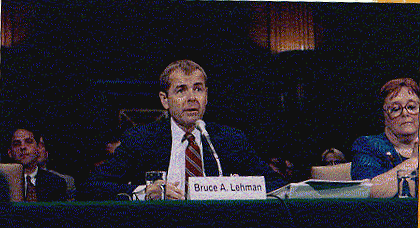
Anti-counterfeiting
P.L. 104-153 (S. 1136), signed into law on July 2, 1996, increases civil and criminal penalties for counterfeiting copyrighted and trademarked products; makes trafficking counterfeit goods or services an offense under the Racketeer, Influenced, and Corrupt Organizations (RICO) Act; expands seizure authority; and makes it more difficult for seized goods to re-enter the market.
Major legislation described below, though supported by the PTO and the Administration, was not enacted.
Omnibus Patent Reform
Omnibus patent reform bills (H.R. 3460 and S. 1961) were introduced in both the House and Senate but did not reach a floor vote. Bipartisan efforts to include the bills provisions in the end-of-the-session w omnibus spending bill were unsuccessful. The bills would have converted the PTO into a wholly- owned government corporation under the policy direction of the Secretary of Commerce. The omnibus bills would have made important patent reforms such as: providing for early publication of patent applications (H.R. 1733); establishing a defense to patent infringement based on previous domestic use (H.R. 2235); regulating invention development service firms (H.R. 2419 and S. 909); and improving patent re-examination procedures (H.R. 1732 and S. 1070). The PTO anticipates that this legislation will be reintroduced by the 105th Congress.
National Information Infrastructure
Also introduced in the 104th Congress, but not passing, was legislation (S. 1284 and H.R. 2441) to assure copyright protection for works transmitted over the National Information Infrastructure. The bills were intended only to fine-tune copyright law as it applies to the new digital environment. Unfortunately, interested parties could not agree on how to deal with on-line service provider liability and devices used to circumvent copyright protection systems. Again, the PTO hopes that the parties reach agreement soon and that the 105th Congress produces a consensus bill.
FY 1996 and 1997 PTO Appropriations
Of fees paid by inventors, $29 million for FY 1996 and $54 million for FY 1997 were not appropriated to the PTO.
The PTO is entirely fee-funded; all of its expenses are covered by the fees its customers pay for issuance of a patent, registration of a trademark, and other services. As a result of the Omnibus Budget Reconciliation Act (OBRA) of 1990, a surcharge is levied on patent fees, and the proceeds are placed in a separate account that is subject to the appropriations process. The surcharge fees amount to approximately 20 percent of PTO's annual revenues. For FY 1996, congressional appropriators gave PTO $82million from the $111 million deposited in the account; approximately $29 million in budget authority was withheld. For FY 1997, congressional appropriators gave PTO just over $61 million out of the $115 million deposited in the account; the other $54million in budget authority was diverted to other government programs. Including these amounts, almost $142 million in budget authority, consisting of fees paid by inventors, has not been appropriated from the patent surcharge account to the PTO since FY 1992. This arrangement is scheduled to expire after FY 1998.
Cooperate with Other Government Agencies
Visiting Scholars Program
Since 1985, the PTO has offered the Visiting Scholars Program to intellectual property officials from more than 30 foreign countries. In two weeks of classroom and hands-on study, participants len about the administration of intellectual property law, patent and trademark examination, and copyright protection, and gain an understanding of intellectual property protection as a tool for economic development. The program includes an introduction to elements of patent and trademark examination such as classification, search, office action preparation, communication with applicants, and final application processing. The program also includes a review of copyright law. This years program (held late October through early November 1996) welcomed participants from t Brunei, Cambodia, China, Estonia, India, Mexico, Saudi Arabia, United Arab Emirates, Ukraine, and Venezuela.
2. Provide our customers with the highest possible level of quality and services.
The PTO's second goal for the agency is to provide its customers with the highest possible level of quality and services in all its operations.
Customer Standards
Patent and Trademark Customer Survey
During 1995 and 1996, surveys were conducted to measure the satisfaction of the PTO's patent and trademark customers. The PTO is using the results of the 1996 survey to target customer service areas that need improvement and to measure change in customer satisfaction since the 1995 survey. Findings of the study are classified by Patents and Trademarks.
Patents
The Patent Process
Customers overall satisfaction with the patent process in 1996 did not change from the 1995 results. The mean score for overall customer satisfaction remained at 3.3 on a 5-point scale, and the percentage of satisfied customers remained at approximately 50 percent.
As in the 1995 survey results, 1996 customers identified the outcome as the most important component of the patent process with staff competence the second most important. Customers satisfaction with outcome and application procedure imp from 1995 to 1996. Customers satisfaction with timeliness, competence of staff, handling of problems, and responsiveness of staff was lower in 1996 than in 1995.
The best predictors of overall satisfaction were outcome of the process, competence of the staff, and decision-making process. In these three categories the greatest gap existed between importance and satisfaction.
Patent Standards
The top three customer priorities have not changed since 1995: (1) conducting thorough searches, (2) clear written communications, and (3) direct you promptly to the proper office or person.
Although most 1996 respondents are satisfied with98. the patent standards, several areas show significantly lower satisfaction ratings than in 1995. Main areas of concern include: clear written communications, conducting thorough searches, and answering telephone calls within one business day. The two areas that did improve are: provide legible correspondence and widely disseminate information on changes in practices and procedures before their effective date.
The best predictors of overall satisfaction were conduct a thorough search, set forth clearly in written communications the technical, procedural and legal position of examiners, and direct you promptly to the proper office or person. an" In these three categories the greatest gap existed between importance and satisfaction.
Customer Priorities in Patent Processes
Customers rated the seven patent process categories from not at all important to extremely important. These also scores were then ranked in order of importance using mean scores. The results for 1995 and 1996 are presented below. All seven process categories were ranked at the same level of importance in both 1995 and 1996. As would be expected, outcome of the process was rated the most important.
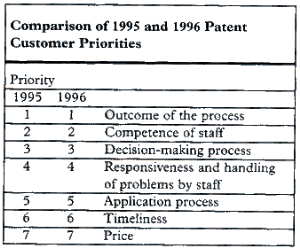
Trademarks
Trademark Process
Customers overall satisfaction in 1996 with the trademark process did not change from the 1995 results. The mean score for the overall customer satisfaction item remained at 3.5 on a 5-point scale, and the percentage of satisfied customers remained at approximately 64 percent.
As in the 1995 survey results, customers identified the outcome as the most important component of the trademark process.
Customers and satisfaction with outcome and application process improved from 1995 to 1996 along with staff competence, staff responsiveness, decision-making process, and price. Customers satisfaction with handling of problems was l1996 than in 1995.
Three of the best predictors (exclusive of price) of overall satisfaction were outcome of the process, application at process, and timeliness. Timeliness, responsiveness, handling of problems by staff, and competence of staff show the largest gap between importance and satisfaction.
Trademark Standards
The top two customer priorities have not changed since 1995. Clear written communications remains the top priority, followed by direct you promptly to the proper office or person.
Although most 1996 respondents are satisfied with the trademark standards, in several areas satisfaction was significantly lower than in 1995. Areas of concern include direct you promptly to the proper office or person, widely disseminate information on changes in practices and procedures, return telephone calls within one business day, respond to status letters within 30 days of receipt, mail correct filing notices within 14 days of receipt, and provide written first communication regarding registrability within three months of filing date. The one area that did improve was clear written communications.
The best predictors of overall satisfaction were set forth clearly in written communications the technical, procedural and legal position of examining attorney; direct you promptly to the proper office or person; and return telephone calls within one business day or, if requested by the caller, provide an alternate point of contact. Determine the registrability of trademarks within 13 months, provide written first communication within three months of filing date, and direct you promptly to the proper office or person show the largest gaps between importance and satisfaction.
Customer Priorities in Trademark Processes
Customer respondents rated the seven trademark process categories on a 5-point scale from not at all important to extremely important. These scores were then ranked in order of importance using mean scores. The top process category was ranked the same in level of importance in both 1995 and 1996. As would be expected, outcome of the process was rated as the most important. Application process moved from the sixth priority in 1995 to second i1996. Timeliness moved from the third priority in 1995 to seventh in 1996.
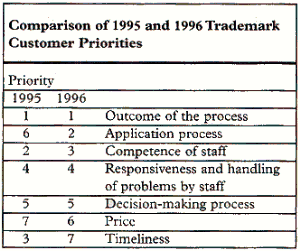
Patent Protection
Processing of patents, one of three core businesses of the PTO, has experienced steady growth in the last decade and is expected to continue growing well into the next century. The PTO is focusing it s efforts to improve the patent process using re-engineering and quality techniques so our customers will be assured of the best possible service.
Applications
In FY 1996, the PTO received 191,116 utility, plant, and reissue (UPR) patent applications and 15,160 design applications.
The UPR patent application filings workload decreased by 13.6 percent from the previous year. This unusual decrease is the result of the transition to a 20-year patent term. The PTO experienced a surge in patent application filings during the week prior to June 8, 1995, the date the legislation making the change became effective. During that week, the PTO received 28,483 UPR patent application filings, over 500 percent more than in the same week of the previous year.
Issues
In FY 1996, the PTO issued a total of 116,875 patents, including 11,346 design patents. This was an overall increase of 2,634 patents over the FY 1995 level.
Pendency
End-of-year average pendency to issue/abandonment time rose to 20.8 months, up from 19.2 months last fiscal year, reflecting the effect of personnel restrictions, restructured funding in the first half of the year because of the lack of full-year appropriations, and the surge in application filings in the years before FY 1996.
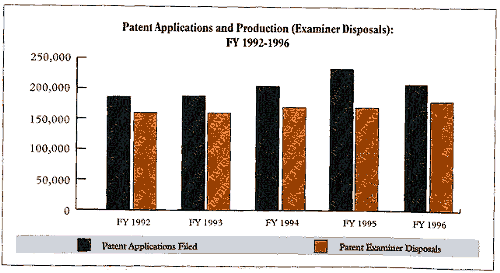
Changes in Patent Law
As a result of implementation of the Uruguay Round Agreements Act (P.L. 103-465), the PTO designed a new model for tracking and measuring pendency. The PTO will begin reporting cycle-time statistics in lieu of pendency effective FY 1997. Cycle time measures PTO time only (discounting waiting time caused by the applicant) per invention from original filing date to disposal by invention. Such reporting will allow for comparisons of examination time attributable to both the PTO (in terms of cycle time) and the applicant (total examination time from receipt to issue or abandonment, less cycle time). These statistics will be further divided by industry sector.
Trademark Protection
Milestones
Several significant trademark milestones were observed in FY 1996. The PTO celebrated the 50th anniversary of implementation of the Lanham Act (Trademark Act of 1946) that modernized early trademark law and still forms the basis of the Federal registration system today. The number of applications filed exceeded 200,000 classes, and the PTO issued trademark registration number 2,000,000. The level of filings and registrations is notable because the current annual increases continue a trend that began with implementation of the Trademark Law Revision Act in 1990.
Applications
In FY 1996, the PTO received 200,640 trademark applications, over 14 percent more than last years 175,307. The number of s applications has increased at higher than anticipated rates, approximately 11 to 14 percent annually, over the last five years. In that time, the trademark application workload has increased 60 percent, though fiscal year staffing levels for the trademark process have increased by less than 10 percent.
Registrations
The number of certificates of registration for trademark applications, including extra classes, issued during FY 1996 was 91,339, representing an increase of 21 percent over the number issued in FY 1995.
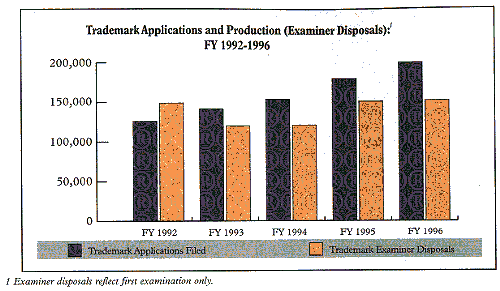
Pendency
Trademark pendency in FY 1996 was 5.9 months from filing to first action and 16.5 months to registration. First action pendency increased from the previous year, although pendency to registration showed slight improvement. Continual increases in workload combined with less than adequate staffing have kept pendency at a level higher than planned.
Trademark examining attorneys completed 198,160 first actions on trademark applications in FY 1996, or 21 percent more than the goal and 12 percent more than the 176,764 actions taken in FY 1995. First actions provide an early indication of the likelihood that an application will be approved and thus are crucial to businesses in making decisions on commercializing their product or service.
Total first examination disposals in FY 1996 were 156,234, an increase of eight percent or 12,183 over the previous year.
As the PTO establishes new work processes, increases efficiency, and attains requested staffing levels, we expect pendency to first action and to registration/abandonment to return to our goal levels beginning in FY 1998.
Changes in Trademark Law
Congress amended the Lanham Act in FY1996 to increase the protection of famous marks against piracy by trademark counterfeiters. It also increased the civil and criminal penalties for counterfeiting copyrighted and trademarked products and made trafficking in counterfeit goods or services an offense under the RICO Act. Finally, Congress expanded the Federal Governments seizure authority and made it more difficult for seized goods to re-enter the marketplace.
Information Dissemination to the Public
In FY 1996, the PTO disseminated patent and trademark information to customers through its search facilities in Arlington, Virginia, the nationwide network of Patent and Trademark Depository Libraries (PTDLs), commercial vendors, and direct sales to end users of the data. The PTO also assisted its customers through its General Information Services Division (GISD). The goals of the information dissemination program are to develop products and systems to assist current and future customers and to take advantage of new technologies and capabilities as they arise.
Public Search Facilities
In its public search facilities, the PTO provided reliable, low-cost access to:
- the Automated Patent Systems Text Search and Retrieval (APS-Text),
- Classified Search and Image Retrieval (APS-CSIR), and
the Trademark Search System (X-Search),
and free access to:
- the Trademark Reporting and Monitoring (TRAM) system,
- the Patent and Trademark Assignment Search Systems, and
- PTO CD-ROM products.
PTDL Program
Through the PTDL program, the PTO disseminates patent and trademark information and supports diverse intellectual property needs of the public. During FY 1996, the New Hampshire State Library, Concord, New Hampshire, and the Texas Tech University Library, Lubbock, Texas, were designated new PTDLs. In addition, 28 libraries across the country offered access to APS-Text for on-line patent searches.
The PTO established a PTDL business partnership with the Great Lakes Patent and Trademark Center at the Detroit Public Library to encourage new interest in intellectual property throughout the Great Lakes region, including nearby Canadian cities. This is our second partnership the first is with the Sunnyvale, California, Center for Invention, Innovation, and Ideas, which expanded services to States on the West Coast. Designated the National Performance Review Reinvention Laboratories, the two centers participated in programs to identify and meet customer needs and to forge relationships with government agencies with related missions. A long-term goal for each is to become a full-service help center, perhaps offering government and commercial publications on patenting, marketing, and exporting inventions. Once the pilot partnerships in Sunnyvale and Detroit are evaluated and the programs are deemed successful, work will begin on establishing partnerships in other regions of the country.
PTO on the Internet
The PTO continues to use the Internet to give users around the world access to patent and trademark information products. The PTO World Wide Web (WWW) site (http://www.uspto.gov) contains the following information about PTO products and services; PTO forms; notices of PTO rule changes, public meetings, and policy announcements; procurement documents; and links to other Intellectual Property Offices. Many products are also available on the PTO's File Transfer Protocol (ftp) site. Accesses to the PTO's WWW site average more than 30,000 per day.
The PTO now has two searchable patent databases on the WWW that are accessible through the PTO's Home Page. The first, under the AIDS Patent Project, is a collection of the full text and full images of U.S. patents related to AIDS research. The EPO, JPO, and WIPO have now joined in the project to provide their own AIDS-related patent information.
In November 1995, the PTO established a second patent database on the WWW. It offers more than 20 years of searchable patent bibliographic text at no charge to the public. The database consists of the front-page text for all patents issued since 1976. It is updated weekly and receives on average more than 45,000 successful requests per day.
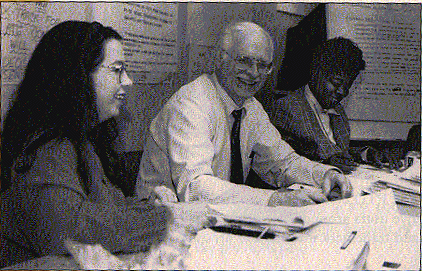
PTO on CD-ROM
The PTO continues to use CD-ROM technology to provide patent and trademark information to the public. CD-ROM products contain searchable text, indexes, and search tools that are updated bimonthly and quarterly. In addition, the PTO produces a weekly patent image CD-ROM that allows electronic delivery of documents to PTDLs, other industrial property offices around the world, and the public. All CD-ROM products can be used, at no cost, in PTO public search facilities and PTDLs, and are sold to the public through annual subscription. Copies of internal databases on magnetic tape are also available.
PTO Through GISD
The PTO's General Information Services Division (GISD) responds to inquiries from the public for general information about patents and trademarks. Modernization efforts allowed GISD to serve more than 520,000 customers in FY 1996 with telephone, mail, and walk-in requests. GISD can be reached toll-free at 1-800-PTO-9199, or in the Washington, DC, area at (703) 308-4357.
Enhance Human Resources
In FY 1996, the Office of Human Resources collaborated with all other areas of the PTO to define its role in the transformation of PTO's business functions. Following is the PTO's vision for human sources management, developed to meet the needs of PTO employees and support its business areas needs:
Human Resources Re-engineering
In March 1996, the PTO initiated a business process re-engineering effort under the Administrator for Human Resources and Public Affairs, which also includes the Office of Civil Rights. The project is examining all aspects of PTO human resources management (HRM), operations, and organizational structure for each of these offices. The goal is to support the needs of PTO's three business areas (patents, trademarks, and information dissemination), s well as all other areas of the PTO. The PTO will initiate a variety of pilot programs to explore options for delivering human resource services, including moving many operations to the business units and contracting out targeted recruitment initiatives.
In FY 1996, the Office of Human Resources (OHR) completed an analysis of current operations and began work on a Concept of Operations (ConOps), which will describe the future OHR environment and operations. In addition to the ConOps, OHR will develop an HRM Business Plan containing the schedule and plans for moving from current human resource management processes to the new re-engineered environment. A final report of this analysis is available from the Office of Human Resources. The ConOps and business plan are expected to be completed early in calendar year 1997.
The Office of Human Resources conducted a study of more than 100 private and public human resource organizations to identify the best practices of these world-class organizations. OHR also conducted a customer focus survey of all human resource functions to establish a baseline from which the office will measure its performance improvement, once re-engineering efforts are under way. Budget reductions may, however, require scaling back, postponing, or eliminating this project.
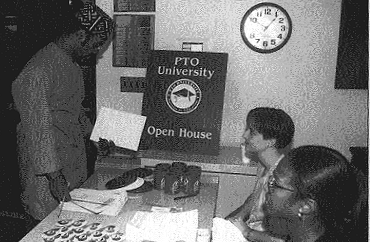
PTO University
In 1994, the PTO created PTO University to promote lifelong learning among current PTO employees. PTO University strives to meet the demands of an increasingly technological and automated workplace. Employees who participate in PTO University programs learn new skills that further their career development and contribute to PTO's competitive place in the global economy. Since FY 1995, PTO University registrations have increased by more than 40 percent; in 1996, over 1,300 employees registered for on-site classes.
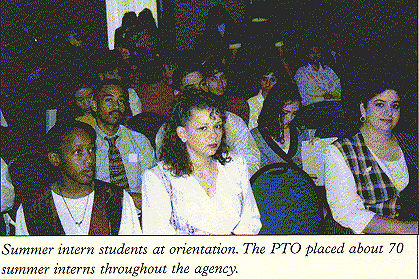
Patent Academy
The Juris Masters Certificate Program (JMCP), a voluntary after-hours program for patent professionals, began in February 1996. The JMCP enables patent professionals who are not attorneys to improve their legal knowledge. The program enrolled 192 students in its first year.
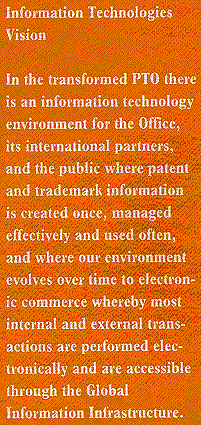 Quality of Work-Life
Quality of Work-Life
In FY 1996, the PTO opened its on-site fitness center. All PTO employees are eligible to join the fitness center for a small fee that is deducted from their paychecks. As a result, the center is nearly self-funded. The center offers state-of-the-art cardiovascular and weight-training equipment, aerobic classes, personal trainers, and much more.
In addition, the PTO's Partnership Council extended the Compensatory Time Pilot Program, which is an additional tool to help employees achieve a good balance between their work and personal lives. PTO employees continue to make use of flexible work schedules, on-site health programs, and transportation subsidies.
Community Service
The PTO continued to establish itself as a good corporate citizen and progressive employer through programs that improved education, health, and personal empowerment. These programs included Project XL, Partnership in Education, and the Lakota Project, a Native American community project in South Dakota.
Leverage Information Technologies
Customers using the patent and trademark systems expect ready access to information and the ability to interact electronically with the Office in a self-service manner. The following vision guided the Offices efforts in FY 1996 to leverage information technology:
In the transformed PTO there is an information technology environment for the Office, its international partners, and the public where patent and trademark information is created once, managed effectively and used often, and where our environment evolves over time to electronic commerce whereby most internal and external transactions are performed electronically and are accessible through the Global Information Infrastructure.
The PTO refined its Strategic Information Technology Plan , publishing an update for FY 1996-2001 in December 1995. The Plan emphasizes the following areas, which are critical to leveraging information technology at the Office:
- maintain current workload production capability;
- make PTOnet robust, reliable, and scalable to meet future needs;
- make all PTO applications accessible from desktop workstations;
- expand the content of and improve access to patent and trademark search databases;
- redesign legacy systems to operate in an open systems environment;
- implement re-engineered patent and trademark business processes; and
- improve electronic information dissemination to external customers.
Budget reductions to programs funded by patent fees, however, may make it necessary to scale back, postpone, or eliminate many of these projects soon.
Patent Automation
The PTO greatly enhanced patent automation capabilities in FY 1996. Highlights appear below.
Desktop Deployment - The PTO deployed approximately 570 desktop workstations to patent examiners.
Group Printer Deployment - The PTO deployed four additional high-speed printers to patent examiners, bringing the total l number of group printers available in a shared environment to 55 machines.
Patent Text Search - The PTO was linked with the premiere Scientific and Technical Network. Through this link, patent examiners are able to search critical foreign patent information. The Offices own text database was expanded to include more than 1 million EPO abstracts and about 500,000 additional JPO abstracts. The PTO also completed an evaluation of a search software prototype.
FormWriter - The PTO replaced handwritten forms with computer-generated, laser-printed forms.
Research and Development Contracts - The PTO and the Defense Advanced Research Projects Agency jointly awarded $11 million in research and development contracts to the University of Massachusetts Center for Intelligent Information Retrieval and the San Diego Supercomputer Center. These awards will enhance the Offices ability to access and evaluate complex technical data in patentd applications relating to electronic commerce.
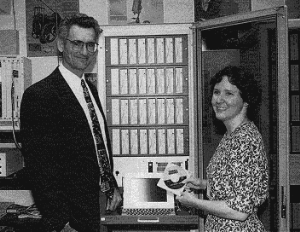
Trilateral Workstation Exchange - The PTO installed workstations that will allow patent examiners to conduct electronic patent searches of the EPO and JPO databases.
Trademark Automation
The PTO released the initial version of the Trademark Electronic Toolkit. The Toolkit allows access to the Trademark Reporting and Monitoring (TRAM) system and the trademark search system (X-Search) via a personal computer over the PTO computer network. It is a major improvement over the existing TRAM query process in that all information for a trademark is retrieved at once, eliminating the need to perform multiple queries.
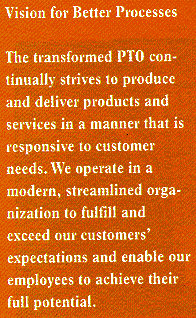 Administrative Automation
Administrative Automation
A select number of users have received the Executive Information System, which provides critical management information to users on-line in a format appropriate to their needs. Also, the Office of Human Resources successfully implemented a paperless system for approving and tracking training forms. Finally, the Office of Finance began processing invoices from vendors with use of an electronic imaging system that enables payments to be approved without distributing paper copies throughout the PTO. The Office of Finance processed more than 17,000 invoices.
Infrastructure
Information Systems Support Contract - The System Development and Maintenance (SDM) support procurement seeks to acquire technical professionals to staff information system development and maintenance projects. This $511 million acquisition is a pilot effort under the Office of Federal Procurement Policy's Past Performance Program. A request for proposals was issued in January 1996. Proposals were received in March 1996, and the PTO expects to award a contract in the spring of 1997.
PTOnet Upgrade - The PTO finished replacing its file server infrastructure with updated components, reducing server downtime from a high of 50 hours per month to around two hours per month.
Magnetic Storage - The PTO acquired 25 terabytes of magnetic storage that will be installed during FY 1997. The new magnetic storage will replace the optical storage devices now used to store patent images, support new and existing requirements such as patent image capture, access to EPO and JPO full patent images, and patent and trademark assignments.
Employ Better Processes
Private sector organizations have responded to changes resulting from a technology-based economy, increased global trade, a changing work force, and advances in information technology by right-sizing themselves. The National Performance Review suggests that government agencies follow the private sectors lead by eliminating obsolete and redundant programs and making better use of automated technologies and advanced telecommunications. The PTO has created the following vision for employing better processes:
Patent Process Re-engineering
Recognizing the need to operate differently in the new global economy, the PTO is re-engineering the entire patent process. A proposed patent process was presented to and approved by PTO executives in November 1995. Budget reductions, however, may require scaling back, postponing, or eliminating this program.
Since then, more detailed discussion and analysis of the proposed re-engineering have taken place, and an annotated Concept of Operations (ConOps) was completed in November 1996. The new process parallels the principles of the Strategic Direction for Patents, which states that by 2003 the PTO will:
- reduce the PTO's processing time to 12 months or less for all inventions;
- establish fully supported and integrated industry sectors;
- receive applications and publish patents electronically;
- exceed our customers quality expectations through the skills and empowerment of our employees; and,
- assess fees commensurate with resource utilization and customer efficiency.
The patent process of the future reflects a new vision of service to the intellectual property community. Pivotal concepts in this process are maximizing value-added activity and using cycle time (cycle time measures PTO processing time only, and does not include any waiting time caused by the applicant) as a primary measure of success, abandoning the pendency-driven system.
A series of test projects is required for transitioning from the current to the envisioned process. FY 1996 project initiatives that will continue in FY 1997 are described below.
Examination Quality - Pilot and evaluate two major components: Coach/Counseling and Customer Involvement. We will emphasize improving the quality of the search performed by the examiner and the thoroughness of the Office action prepared by the examiner.
Industry Sectors - Determine the most efficient organizational units of the Patent Organization for processing patent applications and other service requests. The sectors, which may be correlated to industry, the marketplace, commercial endeavors, etc., will be composed of work groups that examine applications from related technologies.
Patent Assistance Center - Provide trained staff who will offer customers general and technical patent information.
Customer Feedback Cards - Develop and design a Customer Feedback Card to measure the level of customer satisfaction and identify areas for improvement.
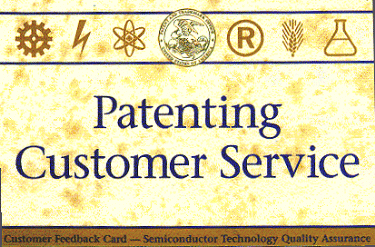
Desktop Workstations - Deploy 1,600 desktop workstations that will allow examiners access to the Automated Patent System.
Patent Image Capture System - Establish processes for high-volume scanning that will enable staff to use electronic images of patent applications.
Prep-Electronic Examination Process - Patent re-engineering automation concepts in a limited electronic examination process.
Technical Support Supervisor Training - Establish training modules and programs for technical support supervisory personnel.
Individual Development Plan - Identify and address training needs and professional development activities for each employee. Create a comprehensive training program. Monitor the progress of employees toward developmental goals.
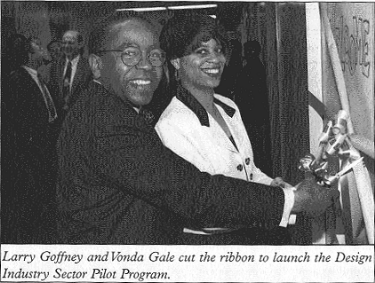
Industry Sectors
The PTO has initiated a major structural reorganization the move to industry sectors. Through industry sectors, resources applied to patent applications can be customized to meet the unique requirements of various customer bases. To improve customer service, components of the patent application processing pipeline will be integrated with the functions traditionally performed in the examining groups. The economies of scale of industry sectors will enable scarce resources to be used most efficiently. Each industry sector will act as a platform for future patent re-engineering initiatives, which can be tailored to the needs of the sectors customer community.
Patent Pre-examination Pilot Review
In December 1995, the PTO initiated the Patent Pre-Exam Process Improvement Project to identify and implement short-term improvements in the processing cycle time. This project was an early step in bringing the current processes closer to the re-engineered solution as documented in the Patent ConOps.
In January 1996, a sample of pending documents in the Office of Initial Patent Examination (OIPE) was reviewed to establish baseline cycle times for application and fee processing. Teams were created to identify problems with the current processes, facilities, technology, and people/organization. By March 1996, the teams had identified short- term solutions to those problems.
Solutions included modified designs of the workflow, cross-training of employees, elimination of redundant tasks, using technology to eliminate several manual processes, and reducing the number of processing queues by combining functions through automation. The improvements were implemented in a pilot that began in July 1996.
Pilot development was coordinated with acquiring and configuring an image capture system. The pilot also incorporated improved internal tracking mechanisms for collecting performance measurements and for providing enhanced management review and control.
Results of the pilot indicate a reduction in pre-examination application processing time, improved fee processing, and reduced time to match time-sensitive correspondence to applications throughout the PTO. The image capture system prototype successfully endorses application papers with serial numbers and dates and is close to moving from testing to a production system to capture patent application images.
Trademark Re-engineering
To respond to the rapid growth in the number of trademark applications received by the PTO since the late 1980s, the PTO has developed a vision of its optimum business environment. This vision emphasizes process restructuring and information technology to achieve large improvements in productivity and customer satisfaction.
The PTO eventually hopes to encourage all applicants who can do so to do business using electronic filing and e-mail. In exchange, applicants will receive substantially improved customer service and quality, and the entire process will work more quickly. The PTO should be able to handle the rapidly increasing number of trademark applications with minimal increases in cost to future applicants and registrants once improvements are in place.
The PTO initiated numerous projects in 1996 that will continue through 1997. Four of these projects have the greatest opportunity to improve production and reduce pendency. Implementation of these four projects is a high priority for trademark re-engineering:
1. Developing the ability to prepare full in-house camera-ready text and images of the Trademark Official Gazette (TMOG) and print registration certificates The transfer of TMOG materials electronically to the Government Printing Office (GPO) will speed up a process that now requires taking drawing pages from files weekly to create camera-ready copies needed to produce the TMOG and registration certificates. The new process, which will allow for printing certificates inside the Office as needed, will benefit a number of Office functions and improve customer service by eliminating the delays caused by submitting requests to GPO.
2. Personal Computer (PC)-based data entry/text editing, including bar code capabilities to update TRAM from a PC All data entry and transactions are now limited to dedicated terminals that cannot be replaced or expanded. Data entry from new applications is limited to 15 dedicated terminals. Improvements are needed to facilitate accurate data entry and text editing features. Expanded access to TRAM from a PC for status information became available in 1996.
3. Scanning paper to capture data and images through Optical Character Recognition (OCR) technology The initial focus will be on learning to use OCR to retrieve documents; this process is dependent on the success of TRAM enhancements.
4. Scanning of incoming documents (drawings first, followed by applications and other materials) The process would allow for records management of scanned documents and distributed printing capabilities, with the goal of eliminating paper. Scanned drawings will be used to establish processes and pilot the concept. Eventually, applications would be received in electronic format through the Trademark Electronic Data Interchange (TEDI). This projects completion will allow for full implementation of electronic filing.
Procurement Re-engineering
The PTO participated in two Department-wide re-engineering projects. The first covers the acquisition process for contract awards greater than $100,000 in value. This projects initial effort focused upon envisioning a new environment with drastically reduced cycle time, improved customer satisfaction, streamlined reviews and approvals, reduced risk, and improved project management. Six pilot teams, three at PTO and three at the Bureau of the Census, tested the concepts independently. Performance goals have been identified and an independent evaluation team has been established to assess overall program benefits.
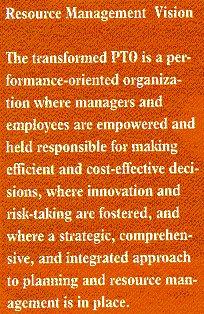 The other re-engineering project covers simplified acquisitions under $100,000 in value. A multidisciplinary team representative of Department bureaus formulated a new target environment. The team completed its work in August and will begin operational testing once the software for the Commerce Acquisition and Management System procurement module is ready.
The other re-engineering project covers simplified acquisitions under $100,000 in value. A multidisciplinary team representative of Department bureaus formulated a new target environment. The team completed its work in August and will begin operational testing once the software for the Commerce Acquisition and Management System procurement module is ready.
PTO Reorganization
In December 1995, the PTO made several additional organizational changes, including establishing the position of a Deputy Administrator for Legislative and International Affairs; consolidating the Offices of Human Resources, Civil Rights, and Public Affairs under an administrator reporting to the Associate Commissioner; transferring the Office of Computer and Telecommunication Operations to the Chief Information Officer; and realigning functions between the Deputy Assistant Commissioner for Patents and the Deputy Assistant Commissioner for Patent Policy and Projects. These changes further streamline management responsibility and provide a flatter and more customer-focused grouping of functions throughout the Office.
Effectively Manage Resources
To maintain and strengthen the viability and soundness of the PTO's financial position and meet the challenges of implementing new government financial management laws (e.g., the Government Performance and Results Act, the Chief Financial Officers Act, and others), the PTO has placed more emphasis on the effective and efficient use of its resources. The PTO's strategy to improve current resource management is to conduct internal evaluations, benchmark the best in business, adopt best practices, eliminate non-valued-added processes, and conduct periodic evaluations. The following is the PTO's vision for effectively managing resources:
Budget reductions to programs funded by patent fees, however, may soon require scaling back, postponing, or eliminating many of the programs implementing this vision.
Fee-Restructuring Study
The PTO began developing cost calculations for PTO current and future products and services. This comprehensive effort, which will continue throughout FY 1997, will result in the development of unit cost models by the end of FY 1997 for products and services of each PTO business area that meets Federal accounting standards. In FY 1996, a limited number of analyses of workloads were in progress that will support future pricing decisions, but much work needs to be done.
The fee restructuring study took advantage of several opportunities in FY 1996 to present customer groups with information on the study and to obtain initial feedback on some fee-setting concepts under consideration. Numerous organizations that represent small inventors also were informally contacted, given general information on the effort, and encouraged to share this information with their members. As additional cost and pricing research data are developed in FY 1997, further communication between the PTO and its customers will be necessary to evaluate how well different fee-setting options meet their needs.
Streamlined Planning, Budget, and Evaluation (PBE) Process
In 1996, the Office continued to implement the redesigned model for the planning, budget, and evaluation (PBE) process that was initiated in FY 1995. The redesigned PBE process is viewed as an integrated, seamless process with a single product. This product, the Corporate Plan, is tailored to meet the requirements of PTO customers, the Administration, and the Congress for planning, budget, and evaluation products. When fully implemented, the comprehensive Corporate Plan will replace our traditional planning and budget documents, although mandatory control documents will continue to be developed as needed.
In FY 1996, PTO Corporate Plan submissions replaced our traditional budget submissions for the Department and the Office of Management and Budget (OMB). Full implementation of the PBE process will take place over several years and will be closely tied to other change projects taking place in patents, trademarks, human resources, and other areas.
Facilities Acquisition
The PTO's leases in Crystal City began to expire in FY 1996, and others will expire in FY 1997. The PTO has e developed a facilities acquisition strategy to acquire new leased space or renovate existing space in order to improve and consolidate facilities, allow for more efficient use of PTO resources, and permit greater flexibility in meeting the PTO's needs in FY 2002 and beyond. Federal regulations require full competition for new leases. Therefore, the PTO has extended certain of these leases and will acquire additional space in our present location to allow both for complete competition for the new leases as well as time for building or renovation.
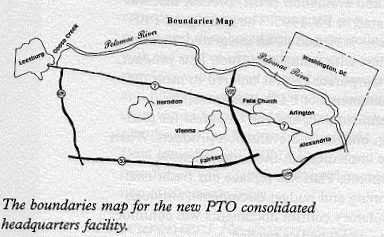
The PTO and GSA worked together in FY 1996 to outline the PTO's needs in a space prospectus. A Solicitation for Offers (SFO) was issued on June 26, 1996. Each potential offeror met with GSA/PTO to discuss the SFO. Under an amendment issued on October 1, 1996, offers for Phase I of the competition will be due by the end of the first quarter of FY 1997. The five best offerors will be selected, and the Phase II request will be issued in the second quarter of FY 1997. Offers for Phase II will be due in the fourth quarter of FY 1997, and a lease will be awarded in the fourth quarter of FY 1998. The earliest date PTO will occupy the new space will be in FY 2002.
Transformational Efforts
Transformational efforts in FY 1996 included business process re-engineering of human resource management, resource management, the acquisition process, and the patent and trademark processes. To prepare for implementation of these major changes, the PTO split operational activities from transformational activities, forming teams of transformational and operational leaders. Operational leaders were responsible for maintaining current operations and for preparing for the implementation of the redesigned processes. Transformational leaders were responsible for test-piloting the redesigned processes and for developing performance measures and critical success factors that will be used to assess the benefits of the redesigns. They were also responsible for developing implementation plans and for the final implementation of the redesigned processes.
Promote Awareness and Encourage Creativity
The Office of Public Affairs continued to expand its informational and educational efforts at the PTO. Public Affairs began several new initiatives, and refined and improved existing programs, as described below.
The Patent and Trademark Museum - During FY 1996, the museum took on a new look and installed two new periodic exhibits. The Bicycle: A Century of Technology celebrated the evolution of the bicycle from a vehicle for the rich to an established method of d transportation and exercise around the world. An exhibit entitled 1946 commemorated the 50th anniversary of the passage of the Lanham Act, the foundation of modern trademark law. In addition, permanent exhibits were consolidated and updated.
American Innovator Award - The American Innovator Award was established to recognize the vital role inventors play in America. This years recipients, all 1995 inductees into the National Inventors Hall of Fame, were: Dr. Forrest Bird, inventor of the respirator; Dr. Joseph H. Burckhalter and Dr. Robert J. Siewald, inventors of the process of identifying antigens to diagnose infectious diseases; Stephanie Kwolek, inventor of Kevlar; Dr. Waldo L. Semon, inventor of PVC (and also bubble gum); and Drs. Robert D. Maurer, Donald B. Keck, and Peter C. Schultz, inventors of fiber optic wire. In honor of the late Commerce Secretary, this award was renamed the Ronald H. Brown American Innovator Award.
Trademark Expo - The 13th annual Trademark Expo was held at the Andrew J. Mellon Auditorium in Washington, DC, in October 1995. Once again, thousands of visitors enjoyed their favorite trademark characters along with historical and educational exhibits tracing the trademark story throughout history.
Project XL - Educators and students continued to look to Project XL, the PTO's educational outreach program, to inspire ingenuity and creativity. In addition to exhibiting at annual conferences and conducting workshops for teachers, Project XL worked with the National Inventive Thinking Association and the Copyright Office on the popular Young Inventors and Creators Program.
National Inventors Hall of Fame - The PTO continued to work closely with and support the National Inventors Hall of Fame and Inventure Place in FY 1996. The PTO again provided financial and human resources for the annual induction ceremony. In addition, the PTO signed an agreement to jointly produce a 10-part radio series entitled Discover the Inventor in You for National PTO Public Radio.
Performance Measurement
In FY 1996, the PTO maintained its commitment to early implementation of the Government Performance and Results Act (GPRA) to strengthen its performance measurement (PM) system. The PTO views a strong PM system as a crucial management tool for improving agency performance. During the year, the PTO integrated PM activities with all process improvements and redesigns and began each of these efforts by establishing a mechanism to integrate customers and stakeholders input and concerns.
The PTO, like most Federal agencies, has an abundance of performance measures that focus on finances, inputs, and outputs. The PTO directed its business area managers to design goals and indicators to monitor performance from many perspectives (quality, efficiency, effectiveness, customer and employee satisfaction, and innovation). The most challenging effort has been the creation of outcome- and results-oriented goals and indicators that determine if the PTO is performing efficiently, is providing the best return to its investors, and is addressing the needs and concerns of its customers and stakeholders.
From late August 1995 through November 1996, the PTO trained an additional 40 senior, staff, and line managers, increasing the number of senior and mid-level managers trained in-house in GPRA and PM to more than 190. The PTO will re-examine the proposed performance goals, listed below, during FY 1997 to ensure that each provides the best reflection of the PTO's progress toward its vision, mission, and strategic agenda.
Performance Goals and Measures
Two important performance goals of PTO policy are to support the economic infrastructure of the United States through the promotion and protection of intellectual property rights in the United States and to expand intellectual property rights systems abroad. The performance measure for this goal is the frequency of exchange of information with foreign countries intellectual property offices.
Two important patent performance goals are to grant exclusive rights, for limited times, to inventors for their discoveries and to provide service to customers. Performance measures include the following: the percentage of patent holders who have paid maintenance fees (first stage, second stage, and third stage), the overall index of customer satisfaction, the number of weighted applications disposed per FTE adjusted for each fiscal year, the unit cost of weighted applications disposed, the number of total applications disposed per year, the number of patents issued per year, the average cycle time of applications, the rate of customer confidence in the accuracy of the decision (customer survey), the overall index of employee satisfaction from the Culture Survey (11 categories), improving employees skills, and the number of process changes.
The primary trademark performance goal is to enhance trademark protection. This goal is intended to address the outcome or benefits of the trademark registration process. The performance goal will direct the trademark planning and budget process and ultimately the way we conduct business. Performance measures include increases in the number of applications filed, the number of trademark disposals per Full-Time Equivalent (FTE), the unit cost of trademark disposals, pendency, and the percentage of files that achieve the Trademark Offices pendency goals.
The primary information dissemination performance goal is to promote awareness of, and provide access to, patent and trademark information. Performance measures include the percentage increase in customers served, the overall index of customer evaluation of ease of access/effectiveness, the overall index of customer satisfaction, the unit cost of key products and services, the percentage of key products meeting published time standards, the percentage of key products filed accurately, and the overall index of employee satisfaction from the Culture Survey.
Baseline data are available for only a few of these business measures. We anticipate that most of the performance information will be available before FY 1999. Once available and validated, this information will help the agency to direct resources appropriately to achieve our goals and mission.
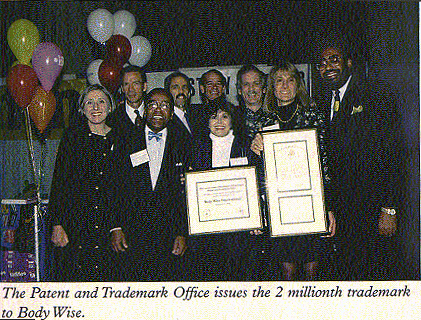
Support for the Department of Commerce Mission
In FY 1996, the Department of Commerce (DOC) articulated its overall approach to promote job creation, economic growth, sustainable development, and improved living standards for all Americans through its mission statement and three strategic themes in a strategic plan. The PTO supports the DOC mission and contributes to DOC's strategic themes by:
- leading the development of intellectual property policy in order to open and expand foreign markets and increase U.S. exports;
- strengthening the intellectual property rights system and disseminating patent and trademark information effectively; and
- administering the laws relating to patents and trademarks; advising the Secretary of Commerce, the President, and the Administration on patent, trademark, and copyright protection; and advising the Secretary of Commerce, the President, and the Administration on trade-related aspects of intellectual property.

